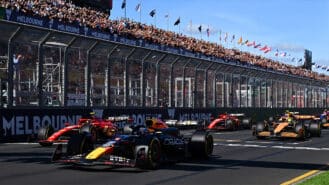So Norris ran away from the pack in the first stint, everyone on inters for a long time and the McLaren’s advantage just increasing the longer that phase went on. Piastri, after having his pockets picked by Verstappen on the opening lap, took advantage of a Verstappen moment on lap 17 as the Red Bull’s tyres began to fade. Piastri quickly brought the 3sec gap to Norris down, as the latter concentrated on looking after the tyres. He got to within DRS range before being called off by McLaren, by which time they had over 16sec on Verstappen. In calling off Piastri around the tricky late inters phase, McLaren was trying to secure the 1-2. But Piastri was keen to race for the win. There are going to be many such situations. By the time McLaren released Piastri to race, he’d had a moment across the Turn 6 gravel and was no longer on Norris’s back.
Later, as they were both on slicks and with a safety car having bunched the pack up, the McLarens were the first to find the sudden rain at Turn 12. Norris rescued a major moment, Piastri went off onto the grass and got stuck there for about a minute. Norris pitted immediately for inters, the closely-following Verstappen stayed out for a couple of laps but ultimately exited around 5sec behind after also changing to inters. Another safety car late in the race gave him a second bite at Norris and he almost got him, as the McLaren flirted with the Turn 6 gravel trap. Almost but not quite.

Verstappen closed in on Norris as the chequered flag approached
Clive Rose/Getty Images
George Russell was always a bit of a distance behind Verstappen and was a solid third. “It was pretty clear from the beginning that these guys were too quick for us,” he said, “and that we were quicker than Ferrari. So, I was kind of in no man’s land. I made a decision quite early on that the best way to approach this race was just to bring it home. If I risked it more, there was no extra reward on the table because they were just so far ahead.” He finished ahead of team mate Kimi Antonelli who drove a great race from his compromised 16th place grid spot, as fast or faster than Russell in the wet.
Ferrari gambled one lap longer than Verstappen on staying out on slicks, hoping the rain would stop, dropping them several places, with Charles Leclerc and Lewis Hamilton ultimately taking eighth and 10th. Without that gamble, they’d have been fourth and fifth.






